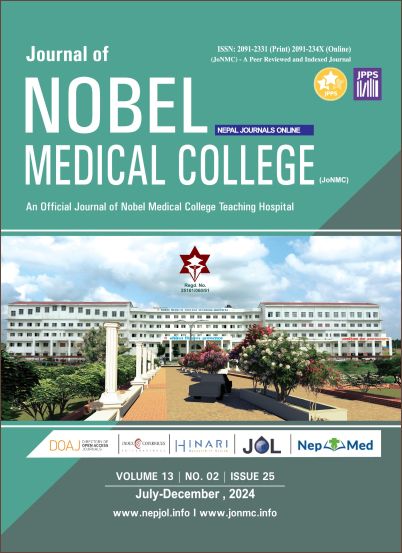Diagnostic Utility of Crush Cytology in the Diagnosis of Large-Intestine Lesions: A Cyto-Histological Correlation Study
DOI:
https://doi.org/10.3126/jonmc.v13i2.74449Keywords:
Biopsy, Colonoscopy, Lower gastrointestinal tract, Malignant neoplasmAbstract
Background: Colonoscopy is a day to day procedure carried out in hospitals for lower gastrointestinal tract lesions. Lower gastrointestinal tract lesions can vary from mild inflammation to infection to malignant neoplasms. Histopathology of colonoscoy biopsy is considered as gold standard but it is a lengthy process taking multiple days to even weeks. Crush cytology is rapid and handy procedure which can be a good adjunct to histopathology. This study highlights the diagnostic role of crush cytology in colon lesions in correlation to histopathology.
Material and Methods: The study was conducted at Nobel Medical College Teaching Hospital,Biratnagar from August 2021 to September 2022 in the Department of Pathology and Gastroenterology among 62 colonoscopic biopsies. Crush cytology smears were prepared and stained with May-Grunwald-Giemsa and ultrapap. Histomorphological slides were prepared and stained with Haematoxylin and Eosin. Both the slides were assessed by 3 pathologists and results were recorded.
Results: This study was done among 62 cases in which the age range was 36-78 years with male to female ratio of 3.1:1. On histopathology, benign lesions were 67% and malignant were 32. On crush cytology, benign pathology was seen in 42 cases, positive for malignancy in 17 and suspicious for malignancy in 3 cases. Sensitivity, specificity, positive predictive value, negative predictive value and overall accuracy of crush cytology when compared to the histopathology were found to be 90%, 95% , 90%, 95% and 93% respectively.
Conclusion: Crush cytology has high sensitivity, specificity, positive predictive value, and negative predictive value and is highly comparable to the histopathology reports.
Downloads
Downloads
Published
How to Cite
Issue
Section
License
Copyright (c) 2024 The Author(s)

This work is licensed under a Creative Commons Attribution 4.0 International License.
JoNMC applies the Creative Commons Attribution (CC BY) license to works we publish. Under this license, authors retain ownership of the copyright for their content, but they allow anyone to download, reuse, reprint, modify, distribute and/or copy the content as long as the original authors and source are cited.




